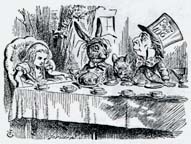"Oh my poor little feet, I wonder who will put on your shoes and your stockings for you now, dears? I'm sure I shan't be able! I shall be a great deal too far off to trouble myself about you: you must manage the best way you can — but I must be kind to them," thought Alice, "or perhaps they won't walk the way I want to go."

The plate that accompanies this episode, a depiction of the Alice who has been telescoped thanks to eating the cake, is certainly odd-looking. Her neck is absurdly long and her head seems almost balanced on top, like a mask stuck on the end of a pole. However, the text suggests a fragmentation in Alice's sense of self. She is so distanced from her feet that she begins to think and speak of them as separate entities that have their own emotions and even their own agency — she must persuade them into "walk[ing] the way I want to go." The sense of fragmentation is not really conveyed in the illustration, nor is this sense of a lack of control over her direction (a lack of control that might be extended beyond the simply physical, especially for a child of this era, who it was said should be seen and not heard). It is true that there is an impression of Alice's body betraying her in surprising ways with the incredibly elongated neck, but the richness created in Carroll's text by the device of Alice's talking to and of her feet is lacking.

In The Victorian Illustrated Book Richard Maxwell argues that the rise of book illustration occurred in a context in which publishers were becoming more and more aware of mass-marketing, and I would argue that this bears itself out in the illustrations of Alice (the character). She is drawn as a pretty, blonde child, the only unusual things about her being her rather adult-seeming face (although it has a China doll prettiness it seems rather older than the seven or eight year old girl she is supposed to be) and her dark eyes, which occasionally give her a mysterious or angry expression (as for instance in the illustration that begins "A Mad Tea Party"). This generic pretty-girl figure seems extremely different to the character presented to us in Carroll's text, who is constantly questioning her identity, how she knows who she is, what her role might be, and who is also rather a threatening figure herself in the world of Wonderland, figured amongst other things as a serpent and a substitute for her cat, Dinah. Tenniel's illustrations never pick up on these figurations, preferring instead to present simply the cherub-faced child.
In her essay "Alice in Wonderland: A Curious Child" Nina Auerbach discusses the physical differences between Alice Liddell, Carroll's model for the character of Alice, and Mary Badcock, Tenniel's model for the illustrations. Alice Liddell is, says Auerbach, 'strikingly sensuous and otherworldly', whilst Mary Badcock 'had little of the dream child about her. She is blonde and pudgy, with squinting eyes, folded arms and an intimidating frown'. These interpretations are rather subjective, but be that as it may, they lead on to Auerbach's making an important distinction between Tenniel's 'Alice' and Carroll's (and here she is referring to the literary character, not to Alice Liddell). She argues that identification of Tenniel's Alice with Carroll's misleads us into "obscuring some of the darker shadings of the latter." I would argue that Tenniel's illustrations go nowhere near exploring the complex depiction of the Alice we are given in Carroll's text.
Questions
1. Can we expect an illustration to convey character as well as appearance?
2. Are there any illustrations in which Tenniel has managed to convey a particular aspect of character well, even if he has not been able to convey the full range?
3. Is Carroll's Alice a character who is constantly unfixed and under construction, to the extent that she could never be represented adequately in a static form?
Do Tenniel's illustrations serve Carroll's text or do they advance an agenda of their own, for example a de-radicalisation of certain aspects of Carroll's text? Do they have a normalising effect?Related Material
- John Tenniel's Natural Fantasy: The White Rabbit
- Representing Alice: John Tenneil's Collaboration with Charles Dodgson
Bibliography
Maxwell, Robert. Rhe Victorian Illustrated Book.
Auerbach, Nina. "Alice in Wonderland: A Curious Child." .
Last modified 25 October 2004